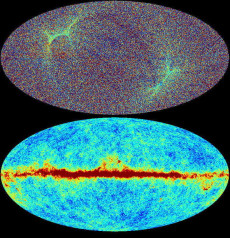Cosmic Microwave Background
The Cosmic Microwave Background (CMB) is relic radiation from a very early stage in the universe -- essentially a "snapshot" about 80,000 years after the Big Bang. In fact, CMB is the most conclusive evidence for the Big Bang. Detailed statistics of the tiny fluctuations in the temperature and polarization of the CMB provide powerful constraints on the origin of the universe and physics at the highest energies. The Planck satellite, launched in May 2009, will make the most precise measurements yet of CMB temperature and polarization over the entire sky for up to 2.5 years. The goal of NERSC CMB project is to analyze the data being gathered by the Planck satellite (although it involves considerably more than just analysis).
Key Challenges: Each raw observation includes contributions from instrument noise, non-CMB radiation from astronomical and terrestrial sources, and the CMB signal inself. These need to be untangled from one another in a precise and meaningful way. The most computationally challenging elements of the analysis of a CMB dataset are those that involve manipulations of the time-ordered data. These include a map-making step and, in particular, a power spectrum estimation step which requires simulating and mapping tens of thousands of Monte Carlo realizations of the entire mission. Furthermore, each realization’s data are correlated — indeed it is precisely the correlations in the CMB that researchers wish to estimate — so we cannot simply divide-and-conquer the data, but instead have to treat it as a single data object.
Why it matters: Precise measurements of cosmic background radiation are critical to cosmology, since any proposed model of the universe must explain this radiation.
Accomplishments: MADmap software developed at NERSC and extensively tested against simulated time-ordered data that include realistic instrument systematics scales to ~10<sup>11</sup> time samples, ~10<sup>8</sup> pixels and ~10<sup>4</sup> processor cores. This software effort was awarded a NASA Public Service Award in 2010.
NERSC Contribution: CMB-NERSC collaboration dates to 1997, and involves extensive I/O improvement and benchmarking, lately Franklin/NGF/DVS tuning; also, extensive use of 256-core Planck Cluster. NERSC's NGF is a key resource – allows production on Franklin/Hopper, analysis on Planck. In addition to Franklin and Hopper the project utilizes NERSC's PDSF (Parallel Distributed Systems Facility) cluster for data analysis.
Investigators: Julian Borrill, Christopher Cantalupo, and Theodore Kisner (LBNL)
More Information: See, for example, Astronomy
& Astrophysics, 467, 761–775 (2007); The Astrophysical Journal Suppl Ser, 187(1) March 2010; Astronomy & Astrophysics 493, 753–783 (2009)l and the Berkeley Center for Cosmological Physics.








